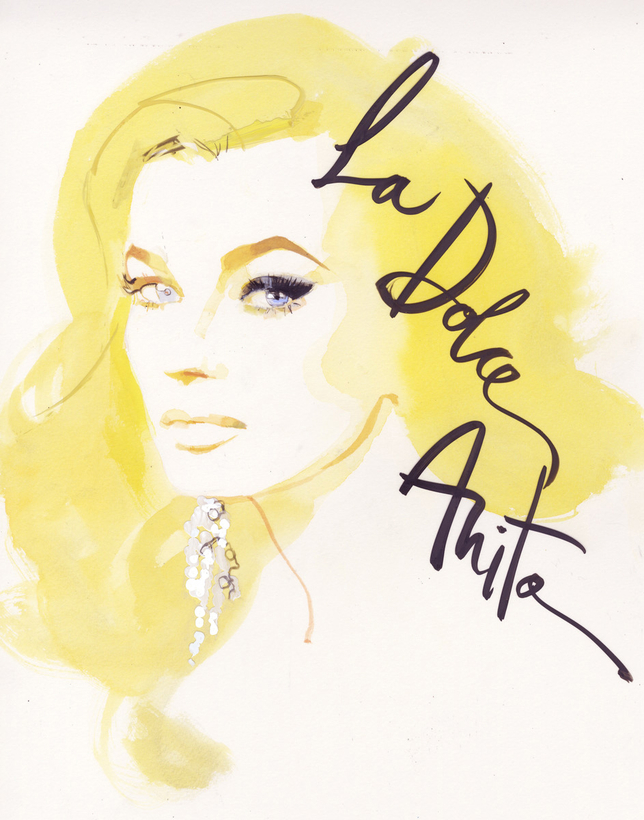“Marcello, come here!” coos movie star Sylvia Rank (Anita Ekberg) to the reporter–gossip columnist Marcello Rubini (Marcello Mastroianni) as she wades around the Trevi Fountain under a silver gelatin moon, in Fellini’s La Dolce Vita (1960). Her dress, cut low and hitched high, unfurls in the water like ink. The cascade goes silent. Nino Rota’s haunting score floats into the air. It is one of the unsurpassable moments in cinema, and with it Anita Ekberg entered into myth.
She was born in Malmö, in 1931, one of eight siblings. At 20, she won the Miss Sweden beauty pageant, a title that brought her to America and to the attention of Howard Hughes. But Ekberg balked at his suggestion that she change her name, her nose, and her teeth and returned home. But soon, she was back in Hollywood and under contract, first to Universal and then to John Wayne’s production company, Batjac. If movies found little for her to do (she was “Vesuvian Guard” in Abbott and Costello Go to Mars and a Chinese peasant in Blood Alley), rapturous layouts in Vogue and Esquire by the glamour photographers Peter Basch and Andre de Dienes highlighted her statuesque Nordic splendor and propelled her to a parallel, pinup stardom. She was known as “the Iceberg,” “the Blonde Venus,” and “the girl who makes Jane Russell look like a boy.” The scandal sheets meanwhile kept a boldfaced tally of her affairs with Tyrone Power, Gary Cooper, Frank Sinatra, and Yul Brynner.
“The girl who makes Jane Russell look like a boy.”
In 1956, in Rome for her first substantial role, Hélène in War and Peace, she and the Eternal City, flush with Hollywood dollars and awash with society high and low, found themselves instantly simpatico. By the time she was back in Italy in 1958 for a sword-and-sandals epic, she was the undisputed queen of the picture-led magazines, Oggi, Tempo, and Epoca, which had sprung up to document after-hours peccadilloes in Cinecittà.
Ekberg did not disappoint: there was the two a.m. punch-up between her husband, the actor Anthony Steel, and a gaggle of “action photographers” (not yet dubbed “the paparazzi”; the term would be another of La Dolce Vita’s legacies) on the Via Veneto; the night at the Rugantino nightclub when she danced barefoot, hair flying, straps sliding, prompting Aïché Nana, a Lebanese would-be actress, to perform a striptease that would land her on the front pages and in court; and the sweltering summer afternoon when photographer Pierluigi Praturlon dutifully recorded her soothing a cut foot in the Trevi Fountain. From his “office” at the Canova bar, Fellini was taking note and deftly wove these picaresque episodes into his concept (there was no script) for La Dolce Vita. After he offered Ekberg the part of a movie star on the loose in Rome, she feared she was being parodied. “Don’t worry,” he replied, “you’re meant to be Ava Gardner.”
The night at the Rugantino nightclub when she danced barefoot, hair flying, straps sliding.
Following La Dolce Vita, Ekberg was again an arresting presence, playing herself as a giant billboard come to life, in the Fellini episode of Boccacio ’70 (1962). After a subdued Hollywood comeback in a Sinatra-Martin-clan Western, she returned to Italy, where she became a citizen. There, she remained a popular star throughout the 1960s, even as the beauty paradigm shifted from sex goddess to waif next door, from the Vesuvian heat of Sophia Loren to the countercultural cool of Sharon Tate.

She claimed her second marriage ended tumultuously in 1975 when her husband, sometime actor Rick Van Nutter, sold her villa, her sports car, her yacht, and even a Chinese junk out from under her and disappeared.
Ekberg, who posed magisterially nude for Playboy in 1978, starred in the delirious thriller Killer Nun (1979) with Joe Dallesandro, before semi-retiring to a villa outside Rome. Surrounded by olive trees, guarded by Dobermans, and supported, it was said, by an old flame, Gianni Agnelli, she gave lively interviews, ice clinking in a glass of her favorite local wine. “It is I who made Fellini famous, not the other way around,” she told one reporter. “It’s not cellular obesity, it’s increased womanliness,” she snapped at another. In 1987, Fellini and Mastroianni called on her at home for the quasi-documentary Intervista, in which the two stars watched the shadows of their former selves at the peak of their beauty. Ekberg’s tears did not seem feigned. “There are no women like her in Japan,” a crew member is heard to say. She died in 2015, a lioness in winter.
David Downton is an artist and fashion illustrator based in London


